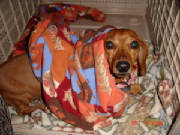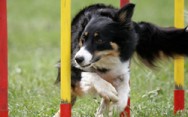Den Training Advice from Las Vegas Dog Trainer, Carol Frisby
Don’t “Cage” your Puppy
Not long ago, I saw a comic strip of a smug looking dog telling a crestfallen looking cat that the reason people don’t keep cats on leashes is because they want cats to run away. It’s a favorite cartoon of mine except that in the edited version in my mind, the dog (complete with its superior expression) is in a crate. Curiously, while most people would never allow an unsupervised, un-diapered infant to crawl around outside of a play pen, many pet parents still just can’t spin the concept of crating – which is the canine equivalent – to the point where it works for them. Therefore, I encourage them to explore Den-training.
to run away. It’s a favorite cartoon of mine except that in the edited version in my mind, the dog (complete with its superior expression) is in a crate. Curiously, while most people would never allow an unsupervised, un-diapered infant to crawl around outside of a play pen, many pet parents still just can’t spin the concept of crating – which is the canine equivalent – to the point where it works for them. Therefore, I encourage them to explore Den-training.
Simply put, den training is based on the theory that dogs are “den” or “denning” animals. All that means is that dogs are actually instinctively programmed to like small, dark, cave-like places or dens that they can use as safe havens. Den training means that the dog learns to accept being confined in a den whenever the doggie parent says so. By the way, denning doesn’t have to mean using a crate. A barrier, or baby gate in the doorway of a bathroom or other small room also works well. Now, if the denning instinct is never actually called upon when a dog is young, it may disappear and trying to teach some dogs that using a den is a good idea can be a challenge. Most dogs however, when properly trained actually love their dens and return to them frequently and willingly on their own.
So, lets get to why we should den train. A key concept in understanding and influencing dogs is that dogs are “in the moment” creatures. Basically, if we want to teach a dog that we do or don’t want him to do something, the easiest way is to catch him in the act of whatever it is. Then we can reward him if we want the behavior, or correct, or redirect him if we don’t want the behavior. As a general rule, dogs (and a great many other living creatures for that matter) tend to increase rewarded behaviors, and decrease unrewarded or corrected ones. So, in order to get Fido trained, we have to react to each and every thing he does until he learns what’s okay and what’s not. Remember, we can should also act to prevent him from doing things we don’t want.
That means that the dog should be either confined or supervised constantly until he learns the rules. By teaching the dog to den on cue, we actually control almost all of the dogs behaviors so that we can reward the ones we want and prevent the ones we don’t want. For example, a denned dog can’t chew up the leg to your coffee table while you’re out. He can’t chew it up because he can’t get to it of course, but if he attempts to chew it up while you’re watching him you can correct him or redirect the chewing to an appropriate object.
Another advantage to den training is that it often helps with potty training. Dogs are programmed not to soil their dens and confining them and letting them out on a schedule can help prevent accidents.
Also useful for getting a dog on the right track is the idea of setting them up to be successful. We want our canine buddy to get stuff right as often as possible and using a den really helps with that. If you head out for a bit and when you get home your house is in shambles, your reaction to Fido may not be very warm and loving. However, if you head out for an hour and leave your dog in his den, when you get home, he’ll be happy to see you, and rather than spending time cleaning up a mess and greeting him with anger, you’ll be able to let your dog out immediately and spend quality, positive bonding time with him. Denning also keeps Fido from injuring himself by preventing him from eating things that may be harmful, or from becoming trapped behind wall units or entangled in electrical wiring etc.
So change the way you look at the concept of confining your dog! You may find it’s just the ticket for ensuring a safe, happy, well adjusted buddy!
Coming soon…the steps to den training.









